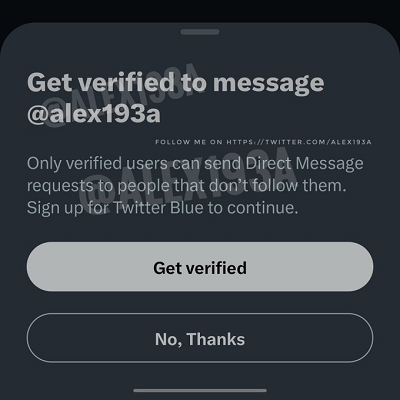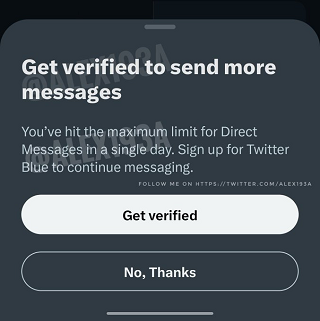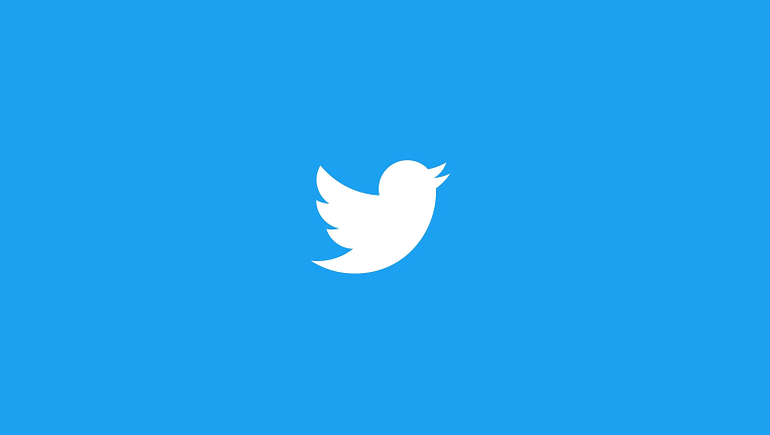After upping its efforts to combat general spam in user feeds, by prioritizing Twitter Blue users in content rankings in the app, Twitter’s now switching its attention to DM misuse, with a range of new measures designed to limit the ways that messages can be used for mass sends, flooding inboxes with random junk that users then need to clear out.
First off, as we reported last week, Twitter’s testing out new restrictions on DM sending, with Twitter Blue users soon set to be the only ones that’ll be allowed to send DM requests to users who don’t follow them in the app.

That’ll significantly restrict people’s capacity to engage in DM spam – though it’ll also impact businesses using Twitter for customer service, and various others who use Twitter DMs to reach out to potential contacts or collaborators.
Of course, you’ll be able to get around this, by paying $8 per month, which Twitter maintains is a form of user verification, enough to weed out spammers at least. And if more people get verified, more people can engage via DM, the impact is reduced, etc.
Elon Musk says that this new element will likely be rolled out sometime this week.
In addition to this, Twitter’s also looking to implement limits on the amount of DMs that non-subscribers can send per day.

As you can see in this example, shared by app researcher Alessandro Paluzzi, Twitter will soon stop users from sending any DMs once they reach a certain limit, with the current daily limit, Paluzzi says, pegged at 500.
Which is a lot. If you’re sending 500 DMs per day, you probably should be paying – but Paluzzi also notes that this number could be much smaller once this restriction is eventually rolled out.
The combined measures will significantly impact DM spammers – though they too will also be able to pay the $8 per month, and keep on sending. I guess, the risk here is that they get reported, and lose their verification as a result – or Twitter makes money from such either way, so it becomes less of a problem for Elon and Co.
But it should work to reduce DM spam, which could be another step towards both improving the messaging experience in the app, while also prompting more people to sign up to Twitter Blue, a win-win for Twitter itself.
As noted, that may have other, unintended impacts, depending on how you use DMs. But Twitter’s response will be to push users towards Twitter Blue, which Elon Musk maintains is the best solution for addressing Twitter’s spam and bot issues.
Which it probably isn’t, but if more people do sign up, it has the potential to address several of Twitter’s challenges in one measure.
Twitter needs more revenue, with Twitter’s overall ad revenue down 40% year-over-year, while it also wants to diversify its income streams, so it doesn’t have to implement moderation and censorship at the behest of ad partners (ad revenue still makes up around 90% of Twitter’s income). And then there’s the verification element. Proper verification would involve confirmation of identity via Government-issued ID, but that also requires manual checking, and thus, additional labor time, so Twitter’s using what it calls ‘payment verification’ as a proxy for ID confirmation – i.e. if a user has a phone number, and a connected bank account, it must be a real person, while bot armies will be harder to construct if they have to pay for each account.
In theory, all of this makes sense. In reality, however, not enough people are paying for Twitter Blue to make this an effective option.
Right now, around 0.28% of Twitter users have signed onto the program, which is nowhere near enough to make this a viable solution on any of these fronts. But Twitter’s sticking with it – though a more effective solution would likely be free verification, via government-issued ID, as opposed to having to pay for such.
LinkedIn’s looking to implement this via a third-party provider, which will reduce manual checking and confirmation on its end. That’ll likely see a lot more take-up, though it’s still a heap of manual work, and Twitter, right now, has less capacity for such than ever, with around 80% fewer staff than this time last year.
So it’ll need to stick with Twitter Blue as its verification stream, for now at least, which will see it continue to implement new measures like this to make the app less functional for non-subscribers, in the hopes that more of them will just pay and be done with it.
I doubt that’s going to happen, but at least Twitter will know, one way or another, whether this is a workable solution in the end.
In other Twitter DM news, it’s also increasing its group chat limit from 50 to 100 people.
Is your group chat running out of space? Starting today, group Direct Messages can include up to 100 people. We’ll increase this limit further over the coming weeks.
— Twitter Support (@TwitterSupport) June 13, 2023
The broader social media trend towards messaging interactions, as opposed to public posting in feeds, has prompted every app to reconsider its messaging elements, and Twitter will be hoping that a bigger group DM limit will provide more capacity for discussion – while Elon also recently agreed with a user suggestion that Twitter Circles should be culled in favor of better DM tools.
Seems like that could be the next thing on the Twitter chopping block.



